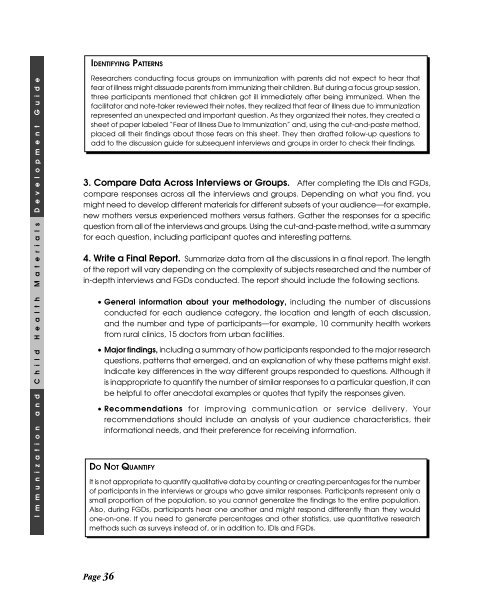Immunization and child health materials development guide pdf
Immunization and child health materials development guide pdf
Immunization and child health materials development guide pdf
You also want an ePaper? Increase the reach of your titles
YUMPU automatically turns print PDFs into web optimized ePapers that Google loves.
IDENTIFYING PATTERNS<br />
Researchers conducting focus groups on immunization with parents did not expect to hear that<br />
fear of illness might dissuade parents from immunizing their <strong>child</strong>ren. But during a focus group session,<br />
three participants mentioned that <strong>child</strong>ren got ill immediately after being immunized. When the<br />
facilitator <strong>and</strong> note-taker reviewed their notes, they realized that fear of illness due to immunization<br />
represented an unexpected <strong>and</strong> important question. As they organized their notes, they created a<br />
sheet of paper labeled “Fear of Illness Due to <strong>Immunization</strong>” <strong>and</strong>, using the cut-<strong>and</strong>-paste method,<br />
placed all their findings about those fears on this sheet. They then drafted follow-up questions to<br />
add to the discussion <strong>guide</strong> for subsequent interviews <strong>and</strong> groups in order to check their findings.<br />
3. Compare Data Across Interviews or Groups. After completing the IDIs <strong>and</strong> FGDs,<br />
compare responses across all the interviews <strong>and</strong> groups. Depending on what you find, you<br />
might need to develop different <strong>materials</strong> for different subsets of your audience—for example,<br />
new mothers versus experienced mothers versus fathers. Gather the responses for a specific<br />
question from all of the interviews <strong>and</strong> groups. Using the cut-<strong>and</strong>-paste method, write a summary<br />
for each question, including participant quotes <strong>and</strong> interesting patterns.<br />
4. Write a Final Report. Summarize data from all the discussions in a final report. The length<br />
of the report will vary depending on the complexity of subjects researched <strong>and</strong> the number of<br />
in-depth interviews <strong>and</strong> FGDs conducted. The report should include the following sections.<br />
• General information about your methodology, including the number of discussions<br />
conducted for each audience category, the location <strong>and</strong> length of each discussion,<br />
<strong>and</strong> the number <strong>and</strong> type of participants—for example, 10 community <strong>health</strong> workers<br />
from rural clinics, 15 doctors from urban facilities.<br />
• Major findings, including a summary of how participants responded to the major research<br />
questions, patterns that emerged, <strong>and</strong> an explanation of why these patterns might exist.<br />
Indicate key differences in the way different groups responded to questions. Although it<br />
is inappropriate to quantify the number of similar responses to a particular question, it can<br />
be helpful to offer anecdotal examples or quotes that typify the responses given.<br />
• Recommendations for improving communication or service delivery. Your<br />
recommendations should include an analysis of your audience characteristics, their<br />
informational needs, <strong>and</strong> their preference for receiving information.<br />
DO NOT QUANTIFY<br />
It is not appropriate to quantify qualitative data by counting or creating percentages for the number<br />
of participants in the interviews or groups who gave similar responses. Participants represent only a<br />
small proportion of the population, so you cannot generalize the findings to the entire population.<br />
Also, during FGDs, participants hear one another <strong>and</strong> might respond differently than they would<br />
one-on-one. If you need to generate percentages <strong>and</strong> other statistics, use quantitative research<br />
methods such as surveys instead of, or in addition to, IDIs <strong>and</strong> FGDs.<br />
Page 36

















